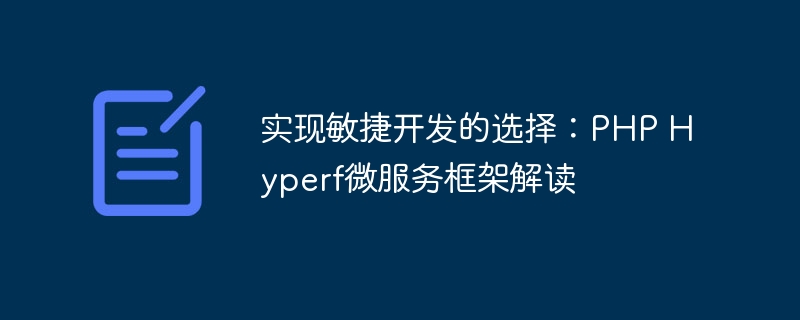Home >Backend Development >PHP Tutorial >Choice to achieve agile development: Interpretation of PHP Hyperf microservice framework
Choice to achieve agile development: Interpretation of PHP Hyperf microservice framework
- WBOYWBOYWBOYWBOYWBOYWBOYWBOYWBOYWBOYWBOYWBOYWBOYWBOriginal
- 2023-09-11 11:58:41792browse

Agile development is a software development method that quickly adapts to changes and focuses on efficient cooperation. In the current Internet era, microservice architecture has become the first choice of developers, which can help development teams better split and manage complex application systems. When choosing a microservice framework suitable for your own team's development, PHP Hyperf is a choice that has attracted much attention.
PHP Hyperf is a microservice framework developed based on Swoole. It focuses on high performance and high flexibility. It has the following characteristics:
First of all, PHP Hyperf is based on Swoole extension and gives full play to the advantages of Swoole asynchronous coroutine. Compared with the traditional PHP framework, it has a huge improvement in performance. Swoole expansion has features such as coroutines, asynchronous IO, and multi-processes, which can effectively improve system throughput and reduce resource consumption. This makes PHP Hyperf a development framework suitable for high concurrency and large traffic scenarios.
Secondly, PHP Hyperf supports the extension of multiple protocols and services. It provides support for multiple protocols such as HTTP, WebSocket, TCP, etc., and can easily integrate and extend other services, such as MySQL, Redis, etc. This enables PHP Hyperf to better collaborate with other services in a microservice architecture to achieve componentization and scalability of the system.
Thirdly, PHP Hyperf provides a complete set of dependency injection containers and global pipeline mechanisms. Its dependency injection container can easily manage the dependencies of various components and provides a more flexible decoupling method. The global pipeline mechanism can process requests and responses globally, and can easily implement various middleware and interceptors. This makes PHP Hyperf more efficient and flexible in request processing, parameter validation, exception handling, etc.
In addition, PHP Hyperf also provides a set of tools for generating API documents, which can automatically generate documents based on comments, reducing the developer's workload in document writing. At the same time, it also supports hot reloading and hot updating, so developers can modify and deploy code without restarting the service.
Choosing PHP Hyperf as a microservice framework can bring the following benefits:
First of all, high performance: PHP Hyperf is based on Swoole expansion, which can give full play to Swoole's asynchronous coroutine characteristics and improve the system. Excellent performance and throughput, suitable for high concurrency and large traffic scenarios.
Secondly, flexible expansion: PHP Hyperf supports multiple protocols and service extensions, and can easily integrate and expand other services to achieve componentization and scalability of the system.
Again, convenient development: PHP Hyperf provides a complete set of dependency injection containers and global pipeline mechanisms, which can easily manage component dependencies and process requests, improving development efficiency.
Finally, visual API documentation: PHP Hyperf provides a set of tools for generating API documentation, which can automatically generate documents based on comments, reducing the developer's documentation writing workload.
In short, choosing the right microservices framework is crucial to achieving agile development. As a microservice framework developed based on Swoole, PHP Hyperf has the advantages of high performance, flexible expansion and convenient development. It can help development teams better implement agile development and adapt to changing market needs. I believe that in future software development, PHP Hyperf will become the choice of more developers.
The above is the detailed content of Choice to achieve agile development: Interpretation of PHP Hyperf microservice framework. For more information, please follow other related articles on the PHP Chinese website!

